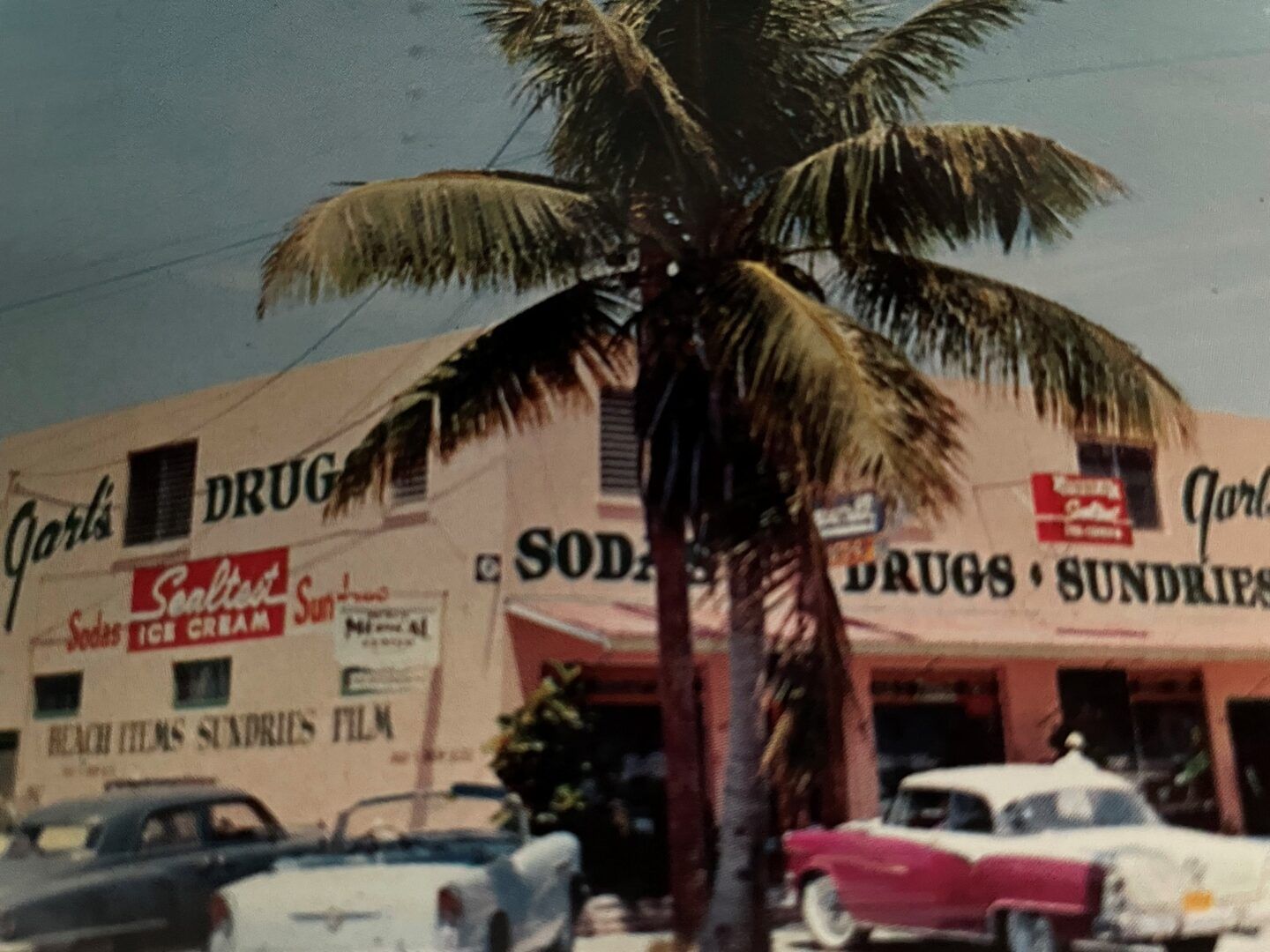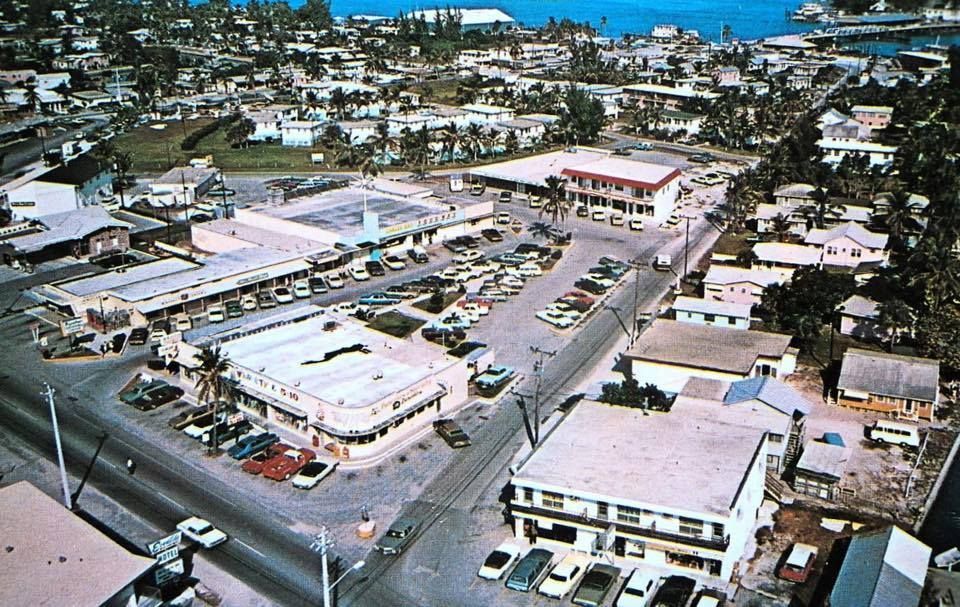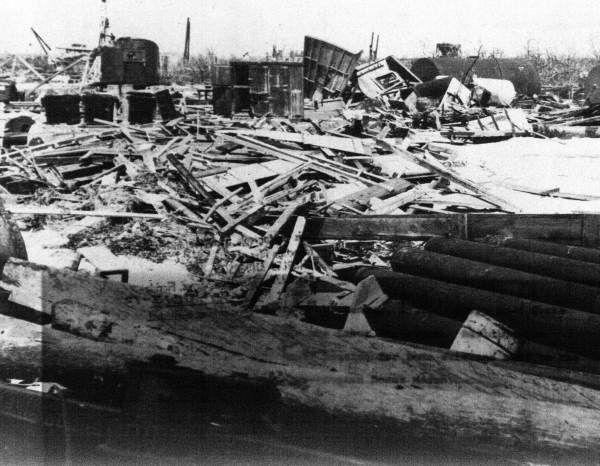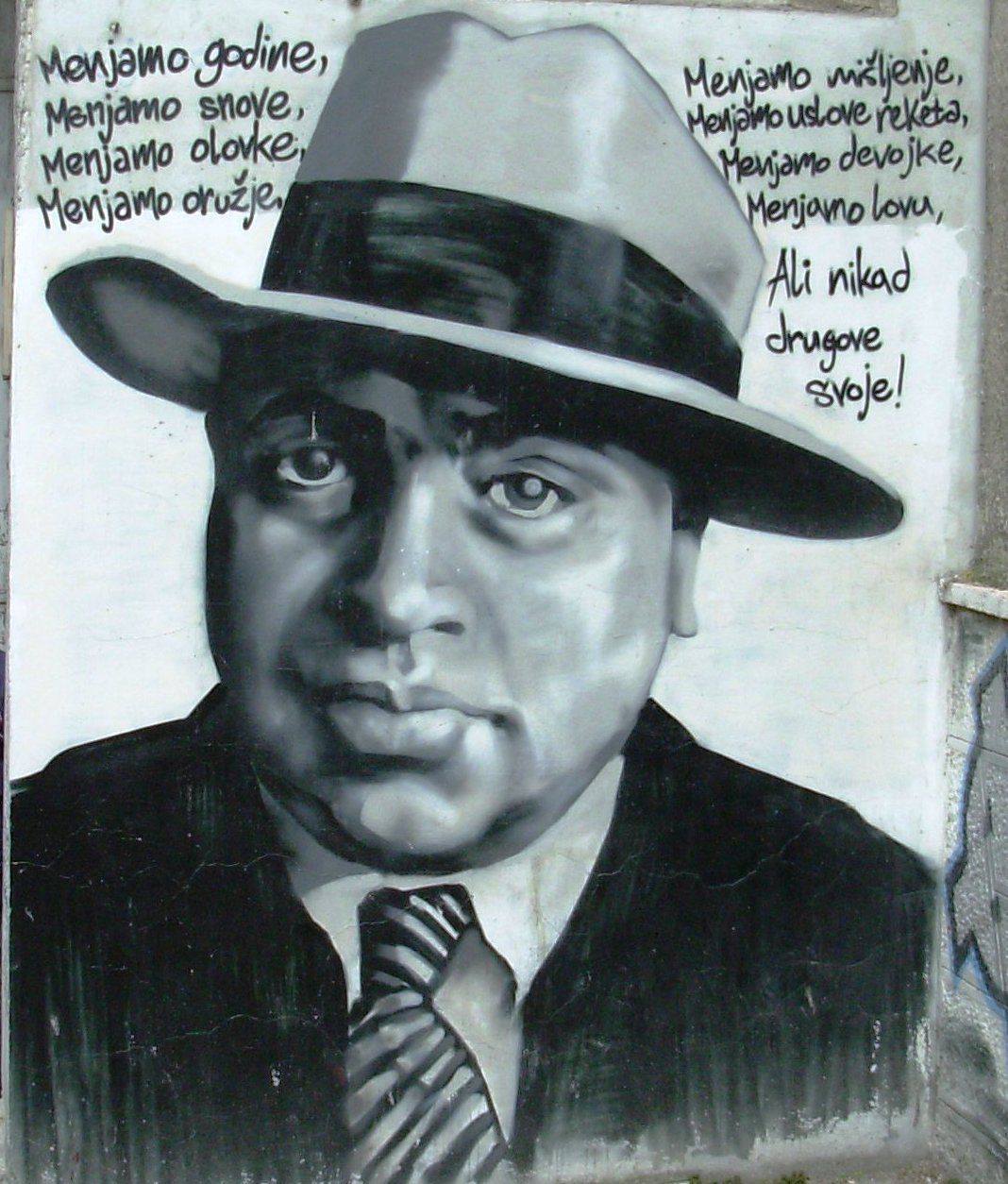Times Square Through the Decades

The Tip Top was a popular hangout for teens back in the day.
Introduction
In the past week, I have watched two different presentations on the redevelopment of Times Square. On Tuesday, June 11, the owners of the properties in Times Square presented their plans for the area. On Wednesday, June 12, a group call Resiliency presented their ideas on different projects including Times Square, Old San Carlos, Newton Park, and Connectivity. Both presentations were informative and now residents can provide input into how they see these ideas being implemented. One of the speakers mentioned that this area of the island has always been subjected to change and has been evolving for the better since 1940. The following is a timeline of the development of Times Square and Old San Carlos over the decades.
The Early Years (1910-1940)

The first pier on the island was at the Beach Hotel, built in 1913 and enlarged in the late 20s.
The first bridge to the island was built in 1921. At this time, the Beach Hotel was the only hotel on the island; there were two casinos (Jack DeLyle’s Seminole Sands at the end of Connecticut and Thomas Philips Fort Myers Beach Casino where the Gulf Shore Grill was located). The only road stopped at the Beach Hotel until the late 30s when it was extended to Connecticut; by the 40s, the road was up to the Catholic church. It was not until the 50s that Estero Blvd went to the end of the island. The center of social activity at this time was the Beach Hotel. The road leading from the bridge to the gulf was paved in 1928 and lined with palm trees. There were no businesses along the road until the late 40s and early 50s.

The concrete road from the bridge to the pier lasted until the redevelopment of Times Square in the 90s.
The Fabulous 50s
In 1948, the second fishing pier was built at the north end of the island on property owned by Thomas Philips. The first pier was at the Beach Hotel and was destroyed in the 1944 hurricane. Shortly after the pier opened, the county purchased land north of the pier for a county park.
This was the beginning of what is now called “Times Square.” Once the pier and park were opened, people came to the island to enjoy swimming, fishing, and playing on the beach. These people needed places to purchase beach supplies, food, and entertainment. Businesses began to spout up around the pier and the park. The Tip Top was a popular place for young people to hang out overlooking the gulf. Across the street were more restaurants, arcades, and souvenir shops.

The County Park attracted visitors from all over to enjoy the beach and the pier.
At this time, traffic came off the bridge and took San Carlos Blvd to the pier where it joined Estero Blvd. All traffic had to pass “Times Square” to get on or off the island.
In the 50s, the residents of the island were either business owners, commercial fishermen, or shrimpers. During the winter, snowbirds would come and stay in the trailer courts, cottage courts, or small mom and pop motels. Some would stay for the entire winter and enroll their children in the Beach School. Although we had visitors, I would not say we were a tourist destination at this time.

Garl’s Drug store was an island icon for many years. Mango Bay was in this building when Ian hit in 2022.
Times Square and San Carlos Blvd developed organically as the island grew. With the pier and the county park at the north end, this became the new social center of the island. In 1951, Harold Garl opened Garl’s Drug Store at the corner of Fifth Street and San Carlos. This became the anchor for development along San Carlos.
Soon, this corridor became a true business district. Charles Bigelow opened Bigelow Shopping Center in the early 50s providing another place for businesses to operate.

Bigelow Shopping Center housed many different businesses and was a one stop shop for residents.
The Swinging 60s
The business district continued to grow in the 60s adding more businesses to the corridor. By the end of the decade, four gas stations, a furniture store, a full-service grocery store, several motels, gift shops, a doctor’s office, a beauty salon, a cocktail lounge and many real estate offices were opened along San Carlos Blvd and in Bigelow Shopping Center.

The intersection of San Carlos and Estero was made one way in the 60s.
At some time in this decade, the traffic pattern was changed to allow traffic to flow onto Estero without going around Times Square. After getting off the bridge, you would continue on San Carlos Blvd until the road split near Winds. If you wanted to visit Times Square or the other businesses on San Carlos, you would continue straight on San Carlos. If you wanted to get onto Estero, you would bear left avoiding Times Square completely.

San Carlos Blvd was the business district for many years until the new bridge was built in 1979.
Sensational 70s
This decade brought many changes to the island. The biggest change was the addition of a new bridge in 1979 which changed the island in many ways. Residents were thrilled with the idea of a new bridge since the old swing bridge was on its last legs and was being blamed for all the traffic issues. The new bridge would eliminate those problems. When the new bridge opened, everything changed in the “downtown” area of the island.

The Sky Bridge brought many changes to the island, but it did not improve the traffic issues as we hoped it would.
The new bridge went over most of San Carlos Blvd and dumped traffic directly onto Estero. Residents and visitors no longer needed to pass all the business that were along San Carlos. New businesses such as a Pizza Hut and a Kentucky Fried Chicken had opened next to some of the older businesses.
To visit these businesses, you had to turn right on Fifth Street and then go back onto San Carlos or forward to Times Square.
The 70s were also a time of growth on the island as the first condos were built in the late 60s so by the 70s developers were quickly buying up the old motels, hotels, and cottages, and replacing them with high rise condos.

By the 70s, the county park had many amenities such as a bath house, playground, and picnic tables.
Electric 80s
The building frenzy of the 70s continued into the 80s with 68 new condo complexes being developed. Unfortunately, this growth did not help the businesses along San Carlos and in Times Square. The change in the traffic pattern caused the deterioration of these areas.
The change in the traffic pattern allowed people to drive around the Times Square area without going down San Carlos Blvd. Mostly young people (me included) liked to get in their cool cars, roll down the windows, blast the music, and drive north to Times Square. They would turn onto Fifth Street and then turn left to go around Times Square where they would “check out” what was going on. If they did not stop anywhere, they would make the loop again. This would happen all day and all-night causing traffic to back up (or so they said).

This is a good shot of San Carlos before the redevelopment of Times Square.
As early as 1987, the News-Press ran an article proposing a pedestrian mall around Times Square. If cars were not allowed to drive down San Carlos to Estero, they could eliminate the loop problem. Although the idea was floated around, nothing really happened until the 1990s.
In the mid 80s, Tom Myers built Seafarers Village at the corner of Estero and San Carlos. The small mall was home to many different businesses including a fancy restaurant, a great deli, a liquor store, and other small gift shops.
Nifty 90s

The 90s was a decade of change in many ways. The high-rise condos continued to replace the cottage courts and motels. The “downtown” area continued to deteriorate as the business that once provided services for residents packed up and left the island. Pizza Hut, Kentucky Fried Chicken, Dockside Pizza, the car wash, and more were gone and the area was considered “blighted.”
In 1994, the idea of a pedestrian mall came up again. At first the idea was met with resistance from the business owners fearing that without traffic going past their establishments, they could not survive. After much discussion, the county decided to try the pedestrian mall idea and then decide whether to make it permanent.

The redeveloped Times Square became a pedestrian mall which eliminated the “looping,” but didn’t help the traffic.
By 1996, Times Square was a pedestrian mall, and most people were on board with the idea. When the town incorporated in 1995, they began working with the county on the redevelopment of San Carlos Blvd and Times Square.
Ground was broken on the new Times Square in 1996 after much discussion and planning. Once the project was completed, businesses in the area started to recover as residents and visitors came to enjoy the new entertainment district.
The new sidewalks, underground lighting, colorful bricks and eclectic buildings made the area funky and there was definitely a beach vibe from the gulf to the bay.
Everything was going well until 2004 when Charley came to visit.
Trendy 20s
Before August 2004, the last hurricane to hit Fort Myers Beach was Hurricane Donna in 1960. Since that time, the island had developed quite a bit with many high rises and more permanent residents. Charley was a smaller storm than Ian and the damage on the island was not nearly as bad as it was in Ian. However, there were some structures that sustained quite a bit of damage and needed to be taken down.

This was the Tip Top after Hurricane Donna in 1960.
By the time Charley hit, the newly designed Times Square and Pedestrian Mall had been completed. After the storm, the town planning continued. The next step in the process was to work on the Estero Blvd Street Scape plan that was part of the original redevelopment process.
In 2004, Dave Meyers purchased Seafarer’s Mall and three other parcels on the gulf side of Estero going from the Sandman Motel to Canal Street. A short time after he made this investment, Hurricane Charley caused major damage on the island, pretty much destroying Seafarer’s Mall and damaging these hotels.
In 2006, Meyers presented a proposal to tear down Seafarer’s Mall and replace it with 65 hotel units and a 220-space parking garage. An investment group known as Time Square FMB was planning to develop this section of the island, but in 2010, they were facing foreclosure. By 2013, the town council and Lee County were in discussions regarding the future of this property. The damaged mall and run-down hotels were considered a blighted area, and the town and the county knew something needed to be done. After much discussion, the county agreed to purchase the land that was home to Seafarers, the Sandman Motel, Howard Johnsons, and Days Inn. Using Tourist Development funds, 5.6 million was paid for the property that was to become a beachside park.

Hurricane Ian destroyed Times Square as plans for its redevelopment continue.
In 2016, TPI Hospitality led by Tom Torgenson, began plans to develop a several large parcels of land on both sides of Estero. Torgenson and his group faced many challenges and oppostions before construction began in August 2021. Hurricane Ian destroyed over 90 percent of the buildings on the island when it hit on September 22, 2022. Although Margaritaville suffered some setbacks, the resort rebounded quickly and opened in December 2023. Despite all the complaining and setbacks, most residents saw the new resort as a beacon of hope for the devastated community.
We are now approaching the second anniversary of Hurricane Ian. Residents and visitors have continued to be drawn to the Times Square area, and it has once again become the social center of the island. As the presenters explained their ideas for the new Times Square, they made it quite clear, that we cannot rebuild the area they way it was. Setbacks and other federal building regulations need to be taken into account in this rebuild.
Now is the time for public meetings and discussions. This was done back in the 90s and was a good way for everyone to provide input. Let’s hope we can come together and support these business owners who are trying to get back on their feet.










